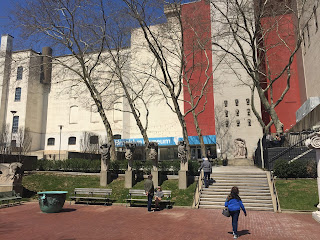Hi everyone!
We have had quite a semester! In this class, we were able to learn about incredible women that have been neglected over the years for their immense talent. I've written an essay that focuses on how women have had struggled in the past with gaining a political stance and gaining recognition. Under the presidency of Donald Trump, women have had lost the faith in the American system. In order to protest his presidency, women around the country marched for their rights. Even after years, women have no political progression in the world. By writing this essay, I've highlighted how women have marched for their equality, and intertwined it with how women in Art suffer the same non-recognition. The art world has been dominated by men willing to overstep and establish their presence, while women hid in their shadows. The presence of women in art has slowly been escalating as our nation regresses to the past. My essay is titled "Same Difference" to highlight the fact that women are different from men in various ways but does that mean that they stand behind them? Of course not! Women deserve the equality that establishes their presences as equals, but highlights their differences instead of masquerading them as weakness. I posted the essay to show a timeline of how women have had to fight their battles in the political and art world.
Check out this Tumblr Page:
https://artispolitics.tumblr.com/
Tuesday, May 9, 2017
Extra Credit: Brooklyn Museum
Emily Zuniga
Professor Cacoilo
 Art and Women
Art and Women
Professor Cacoilo
 Art and Women
Art and Women
The Brooklyn Museum
Going to the Brooklyn Museum was awesome to the say the least. I was excited to see the exhibitions, most importantly, The Dinner Party. I never went farther than Manhattan so it was a cool experience to go outside of my comfort zone. The museum itself is very modern and serene.
Judy Chicago's The Dinner Party
 |
| Judy Chicago, The Dinner Party, 1974–79. |
Judy Chicago's installation at the museum is massive and captivating. The detail put into every plate setting and the tile work that each setting stands upon is mesmerizing. Celebrating female figures, historically and mythically, that have impacted civilization, yet have been overlooked. Chicago gives each one a unique place setting that represent her interpretation of them. All the porcelain plates resemble flowers, wombs, and vulva playing on the female sexuality in her feminist piece. Place on embroidered tablecloths, every female's name is at the bottom and decorated with characteristics of the women. Each plate is delicately molded and painted through Chicago's vision. By giving them a place setting, Chicago is honoring these women who were unable to obtain the deserved recognition in their time period. Referencing the Last Supper, Judy Chicago's installation plays on the idea that women are behind everything, yet only men are recognized. Considered it radical at the time, her art shook art critics and was condoned to be to liberal or not even considered art by definition. The Dinner Party gives viewers the massive notion that women have come a long way in society and by physically giving them a place setting keeps them alive in today's patriarchal world. Chicago's work reveals the breadth of research of art history, feminism, and general history to understand their struggles. Going beyond the books, Judy Chicago brought the accomplishment of previous women to life and dealing with female subject matter. The Dinner Party in total represents 1,038 women in history, 39 of them are represented by a place setting and other 999 names are inscribed in the heritage floor. The floor is made up of more than 2,000 white tiles with gold script lettering. Chicago is known for her large collaborative art installation pieces which examine the role of women in history and culture.
 |
| Judy Chicago, The Dinner Party, 1974–79. |
The most significant element in this artwork is texture. Each plate has a design where you can visually see the texture and can imagine what the design would feel like if you could actually touch it. The most significant principle is emphasis and focal point. Each setting has a focal point of the circular china plate in the middle of the runner. This plate represents the most important statement of the piece, that is why it is located in the center. The focal point is symbolizing the women in which Chicago is representing at each setting. Chicago wants you to notice the center piece, she makes emphasis on each setting by using her design of the vulvar or butterfly form. By having the plate be the focal point, it draws the viewers eye to the center of the place setting, recognizing what is important about this artwork, and knowing women are important in our history. Chicago created this large piece to show the achievements of women, and she choose to use historical women to make her point to the viewer.
 |
| Judy Chicago, The Dinner Party, 1974–79. |
 |
| Judy Chicago, The Dinner Party, 1974–79. |
Themes of gender are definitely illustrated with each plate setting resembling female genitalia. Furthermore, Chicago reclaims stereotypes of femininity by emphasizing domesticity through the form of the installation. The installation itself, a dinner table, reflects the expected domestic responsibilities of women to cook meals and prepare the dinner table. Chicago ties in more motifs of female gender roles through the focus on craftsmanship: all the table clothes and ceramics are made by hand. Chicago uses these crafts to emphasize, affirm and reclaim the feminine identity.
The Dinner Party serves as a reflection of the growing social acknowledgement and recognition of women in American society. This empowering set up glorifies and emphasizes on the female body.
 |
| Judy Chicago, The Dinner Party, 1974–79. |
 |
| Judy Chicago, The Dinner Party, 1974–79. |
 |
| Judy Chicago, The Dinner Party, 1974–79. |
Bibliography:
https://www.brooklynmuseum.org/exhibitions/dinner_party
http://www.judychicago.com/gallery/the-dinner-party/dp-artwork/
Subscribe to:
Posts (Atom)
